الأربعاء، 7 ديسمبر 2016
الاثنين، 5 سبتمبر 2016
الثلاثاء، 10 مايو 2016
obama is begging for a job !! jobless !!
will propose to employer-sponsored retirement plans could help 30 million American workers have access to retirement savings, the White House said Monday.
Obama's plan consists of of a number of legislative proposals, which he'll outline in the 2017 budget he'll submit to Congress next month. They include:
► Offering tax credits to small businesses that automatically enroll employees in a new 401(k)-style retirement plan — or requiring them to offer payroll deductions to an Individual Retirement Account if they don't offer a company plan.
► Requiring companies with existing plans to offer them to long-term, part-time workers who work 500 hours a year for three years; and
► Making it easier for companies to pool their retirement plans to bring down expenses through multiple employer plans.
The White House previewed the proposals for reporters Monday but did not immediately reveal their budgetary impact. In addition to the newly proposed tax credits for businesses, the changes would give millions of Americans a tax cut by allowing them to defer taxes on their retirement savings.
The retirement proposals are part of an economic security agenda Obama outlined in his State of the Union address this month, which also included a call to expand unemployment benefits. "For Americans short of retirement, basic benefits should be just as mobile as everything else is today," Obama told Congress. "Even if he’s going from job to job, he should still be able to save for retirement and take his savings with him.”
The president will propose an as-yet-undisclosed amount of money to experiment with more portable retirement plans, run by states and non-profits, which would accommodate workers who move from job to job or who have more than one employer at a time.
The National Institute on Retirement Security found last year that the median retirement account balance for all working-age Americans is $2,500 — a number that increases to just $14,500. for those nearing retirement. Many of them just need to get started, said the institute's executive director, Diane Oakley. "What I like about this proposal is it still tries to provide some important incentives for employers to take the next step," she said.
Obama's proposals would require action by a Republican-controlled Congress in an election year session, but Obama has expressed optimism he can still work with Congress on the issue.
In fact, the election could help force Congress to get something done this year. "America's middle class is feeling economically insecure," said Christian Weller, a professor of public policy at the University of Massachusetts Boston and author of Retirement on the Rocks. "Economic anxiety is driving a lot of the support for Donald Trump, and also for Bernie Sanders."
Weller said the Obama proposal's "soft mandate" for employers to give employees an IRA option is a significant change to the voluntary, employer-based system of retirement savings. "If you're an employer who's not doing anything, you at least have to maker it easier for an employee to save on their own through a payroll deduction option," he said.
The Republican chairmen of the tax-writing committees of Congress, which have jurisdiction over retirement plans, had no comment on the proposals Tuesday. But they've been working on their own proposals, and the Senate Finance Committee will hold a hearing Thursday on the issue.
"These items shouldn't be particularly controversial," Labor Secretary Tom Perez told reporters Monday. "In fact a lot of these ideas enjoy bipartisan support and have bipartisan roots." Auto-enrolling employees in a retirement plan, for example, has been proposed for years by both the conservative Heritage Foundation and the center-left Brookings Institution.
Perez said many small businesses worry that the administrative and compliance burdens are too costly for them to offer a retirement plan — obstacles that the administration's proposals try to address.
"What we're trying to do is recognize those barriers and address them," he said. "We want to increase access, we want to reduce burdens, but at the same time we want to make sure
there are sufficient consumer protections in place."
it won't be enough. Here's why.
The federal government today launched a program called myRA, a “starter” retirement savings account for people who don’t have access to a 401(k) at work or don’t have enough money to meet the minimum balance requirements on many private-sector IRA accounts.
In his announcement, Treasury Secretary Jacob J. Lew touted it as a cheap, convenient, and risk-free way for people who otherwise wouldn’t be able to sock some money away for their retirements.
Government statistics show that nearly a third of people who aren’t already retired say they don’t have any money set aside through a pension, 401(k) or other retirement account. More than 40% of people who don’t have a 401(k) say it’s because their job doesn’t offer one, and more than 60% of part-time workers don’t have employer-backed retirement accounts.
Here’s what you need to know:
It’s really just a starter account. MyRA isn’t meant to be a stand-alone retirement plan. There’s only one investment option—a Treasury bond that recently earned about 2%. That’s more than a typical savings account, but it’s not the kind of return investment experts say people need to accumulate a good-sized nest egg. The trade-off is that it’s principal-protected (you can’t lose the money you put in) since the money is invested in a government security.
الإموجى !
صور الرموز التعبيرية ”ايموجي“ المستمرة في التطور :
”ايموجي“ هي أيقونات على الأجهزة الرقمية عبارة عن صور تستخدم كحروف أو رموز للتعبير على المشاعر والأحداث. وكلمة ايموجي emoji هي مصطلح باللغة اليابانية مكون من كلمتي ”إيه e“ وتعني صورة و”موجي moji“ وتعني حرف، وقد تم تسجيلها في قاموس أوكسفورد الإنكليزي عام ٢٠١٣.
صور الرموز التعبيرية ”ايموجي“ وتعرف أيضا برموز المشاعر، والتي بدأ ظهورها من داخل ثقافة الهواتف المحمولة في اليابان، قد أُدخلت بعد ذلك في عام ٢٠١٠ بفضل تحركات من آبل Apple وجوجل Google وغيرها، في نظم الحروف الدولية الموحدة يونِكود ٦.٠ (Unicode 6.0) وأصبحت تستخدم اليوم في هواتف الأيفون، خدمات مجانية للبريد الإلكتروني على الإنترنت مثل Gmail، والشبكات الاجتماعية مثل Facebook وTwitter، Tumblr إلى آخره.
القصة الخفية وراء ولادة صور الرموز التعبيرية ”ايموجي“
إن النموذج الأولي لصور الرموز التعبيرية ”ايموجي“ الحالية كان عبارة عن مجموعة تتكون من ١٧٦ صورة بأبعاد ١٢x١٢ بكسل خاصة لاستخدامات الهاتف المحمول والإنترنت قام بصنعها كوريتا شيغيتاكا، الذي كان وقتها عام ١٩٩٨ موظفا في شركة NTT DoCoMo (موظف تنفيذي في شركة Dwango حاليا)، وذلك من أجل أن تستخدم في أول نظام أساسي لخدمة الإنترنت الخاصة للهاتف المحمول في العالم i-mode المطور من DoCoMo. وحيث أن الإتجاه السائد في الخطابات اليابانية يميل إلى استخدام الكثير من عبارات اصطلاحية لجمل التحية والتهنئة بالفصول المختلفة وغيرها مما يجعلها طويلة، فقد جاءت فكرة كوريتا في عمل الايموجي لتكون أيقونات تعبّر مباشرا على هذه الجمل ببساطة وتظهر المشاعر الكامنة خلفها. والكثير من التعبيرات التي فكر بها وأخرجها كوريتا بكل ما أوتى من قوة، حيث أنه لم يكن قد درس أو له صلة بعلم التصميمات، كانت أفكار وخيالات متبعثرة من الكانجي ورسومات المانغا التي كان يقرأها في الصغر.
وقد تقدمت DoCoMo حينها لتسجيل الايموجي من أجل الحصول على حقوق الطبع والنشر ولكن لم تحصل عليها حيث قيل إنها إذا كانت مجرد صور لا تتعدى أبعادها ١٢x١٢ بكسل فيمكن لأي شخص عمل مثل تلك التعبيرات. لذلك فقد تمكنت الشركات المنافسة الأخرى من استخدام الايموجي الخاصة بـDoCoMo بحرية وهو ما أدى إلى انتشار وتوسع ثقافة الايموجي الحالية. وتعتبر سهولة الاستخدام وشكلها اللطيف والمرح هي من أهم أسباب استخدامها ولكن هناك نقطة أخرى كبرى تتمثل في إمكانية التعبير عن المشاعر وتبادلها في روح من الدعابة.
بعد ذلك، قام رئيس شركة SoftBank للهواتف والإنترنت سون ماسايوشي، مع وقت بداية إطلاق نظام التشغيل iOS2.2 للأيفون في اليابان عام ٢٠٠٨، بالتفاوض مباشرا مع ستيف جوبز من أجل تزويد إمكانية استخدام الايموجي. والآن الايموجي أو صور التعبيرات الرمزية التي كانت في بداية الأمر خدمة مقدمة فقط لليابان أصبح يمكن استخدامها في جميع أنحاء العالم.
أصل بداية الرموز الوجهية emoticon من القرن التاسع عشر ؟
ومن ناحية أخرى، هناك وجوه تعبيرية تصنع من الحروف والرموز ”وجه تعبيري “emoticon التي تستخدم في البريد الإلكتروني والمدونات، قد ظهرت قبل صور الرموز التعبيرية ”ايموجي“ وتتعدد الأقاويل وراء بداية نشأتها والتي يبدو أنه يعود إلى منتصف القرن التاسع عشر. والوجوه التعبيرية تعرف بـ ”smileys“ أو ”emoticons“ بالإنكليزية. والوجوه التعبيرية التي تستخدم في اليابان يُعبر فيها عن المشاعر بتغيير رمز شكل العين كما في هذه الوجوه (^_^)، (>_<)، أما في أوروبا وأمريكا فيكون كما في (: و D: حيث يكون الرمز نائما بشكل عرضي ويُعبِّر فيه عن تعبير الوجه المطلوب من خلال تغيير الرمز أو الحرف الممثل للفم. و”الغمزه“ مثلا في اليابان يُعبر عنها بـ ☆-(-_^) أما في أمريكا فتكون بالشكل (-; . والوجوه التعبيرية توسعت وانتشرت مع انتشار الإنترنت وترتبط بشكل مباشر بثقافة صور الرموز التعبيرية الايموجي الحالية.
كلمة عام ٢٠١٥ لقاموس إكسفورد الإنكليزي!
وبالرغم من أنها بدأت تنتشر في العالم، إلا أن صور الرموز التعبيرية ”ايموجي“ هي في الأصل خاصة بنظام i-mode الذي طور في اليابان، لذلك فقد بقي تأثير اللون الياباني عليها في عدة جوانب. وقد نشر في مقالة لـNew York Times بعنوان ”America Needs Its Own Emojis“ لإظهار نوع من الاستياء والرجاء بطريقة دعابية عن أنه بالرغم من وجود صور رمزية خاصة باليابان مثل صورة رمز الأونيغيري وشكل شخص يرتدي قناع، إلا أنه لا توجد صور رمزية خاصة بثقافة الأمريكيين كالديك الرومي أو الفراخ المحمرة أو حتى البوريتو ! بالإضافة إلى عدم وجود إشارة رفع الأصبع الأوسط ..!
وفي السنوات الأخيرة قد ازدادت نسبة استخدام أيقونات الايموجي في أمريكا وبرطانيا وحسب ما ذكر في مدونة قاموس إكسفورد الإنكليزي فقد أُختير مصطلح ”Face with Tears of Joy’ emoji“ أي ”وجه بدموع الفرح“ ليكون كلمة العام لقاموس إكسفورد الإنكليزي ٢٠١٥.
كذلك، فقد استخدمت المغنية الأمريكية كاتي بيري Katy Perry في الفيديو الغنائي لأغنيتها ”Roar“ الايموجي للتعبير على كلمات الأغنية ليجذب إليه الكثير من الأنظار والأحاديث.
كاتي بيري Katy Perry في الفيديو الغنائي لأغنيتها ”Roar“
الايموجي والملصقات في تطبيقات برامج التواصل
ومن جهة أخرى، ومع تزايد مستخدمي تطبيقات التواصل الخاصة بالهواتف المحمولة مثل لاين LINE فقد تزايد عدد الأشخاص المُرسلين للملصقات “stickers”. والملصقات هي عبارة عن صور توضيحية خاصة بتطبيقات مثل LINE وFB Messenger يتم تحميلها مسبقا للاستخدام وتشمل العديد من أشكال الشخصيات المختلفة. كما توجد ملصقات متحركة وبلغات مختلفة بالإضافة إلى أنه يمكن صنع الملصقات الخاصة بك على ذوقك واستعمالها وبيعها أيضا. وهناك ملصقات مع إعلان شركات ويكون استخدامه بالمجان، وآخر يكون استخدامه بمقابل مادي. ومؤخرا أصبح الاتجاه أأن يستخدام صور الرموز التعبيرية ”ايموجي“ وهذه الملصقات التعبيرية أو المتحركة ”استيكر“ معا أثناء تبادل المحادثات لإيصال التعابير والمشاعر المختلفة للطرف الآخر.
وعلى غرار الكلمات ذات الأصل الياباني مثل ”كاراوكي Karaoke“ و”كاواي Kawaii“ وغيرها التي أصبحت مصطلحات عالمية مشتركة فقد لحقت بهم كلمة ”ايموجي Emoji“. ونتطلع بشغف لما قد يظهر من استخدامات أخرى فريدة ومختلفة لها في وسط هذا الانتشار العالمي المتزايد.
الرموزالخاصة باللإموجى للكتابة على الفيس بوك
the kingdom of amazing uniforms !
A Sea of Uniformity
Japan must be one of the most uniformed nations in the world. Student uniforms are seen from elementary through high school and sometimes even at colleges. And employee uniforms (mainly for women) are worn at workplaces ranging from tiny firms to giant corporations, from lavish showrooms to little shops selling mobile phones. Where else does the culture of the uniform thrive as it does among the Japanese?
What I think is especially interesting is that we see people voluntarily wearing virtually identical clothes even in some cases where uniforms are not required. A good example is the student job-hunter look: black suits of a standard design that reveal nothing of the wearers’ individuality. For practical purposes these are the same as uniforms. So are the prim suits that mothers buy for themselves and the stereotyped outfits they get for their children as they seek spots for them at private elementary schools. “Pseudo-uniforms,” we might well call this attire.
So Japan’s uniform-wearing culture features two types of uniform: the mandatory regular uniform and the voluntarily worn pseudo-uniform. Let’s look at both.
Advantages of the Mandatory Uniform
Regular uniforms, the mandatory attire for those attending a particular school or working at a particular job, have a number of functions. I think we can sum them up in the following five items.
1. Identification
A uniform identifies the wearer’s status as a member of a student body, a sports team, or the staff at a workplace, making it readily apparent to others what role the person is playing. The uniforms worn by hospital nurses and department store clerks are good examples of this.
2. Pride and Motivation
Wearing a uniform helps motivate people to perform their role at their school or workplace and appeals to their pride. Consider the red jackets worn by the Shinkansen cleaning crews of JR East Tessei. Cleaning is important, but it is not a glamorous job by any means. By outfitting its cleaning team members in bright red jackets, Tessei called attention to them, boosting their pride in their jobs and enhancing their motivation.
 A Tessei cleaning crew wait to board a bullet train arriving at Tokyo Station. (Photo courtesy of JR East Tessei)
A Tessei cleaning crew wait to board a bullet train arriving at Tokyo Station. (Photo courtesy of JR East Tessei)
The special uniforms worn only by those with advanced skills have a similar effect. For example, copilots’ uniforms have three stripes on their sleeves or shoulder epaulets, while pilots have four. This is another way of appealing to pride and building motivation.
3. Safety and Comfort
The uniforms worn by factory workers are an example of regulation wear that enhances safety and comfort. The uniforms are designed to be easy to work in, and they help protect the wearer from harm on the job.
4. Brand Promotion
Uniforms can also promote the brand image of a business. A typical example is the attire of the female flight attendants on Singapore Airlines. Their ethnically inspired uniforms have been unchanged since 1972 and have become a widely recognized trademark for the airline, greatly boosting its brand.
5. Recruiting Power
Many uniforms also enhance the organization’s recruiting power by making people want to work where they are worn. The uniforms of the “cast members” at Disneyland are a good example.
 All Nippon Airways flight attendants model the uniforms worn by cabin crews since the airline launched its international service 30 years ago, at an event at Narita Airport, March 3, 2016. (© Jiji)
All Nippon Airways flight attendants model the uniforms worn by cabin crews since the airline launched its international service 30 years ago, at an event at Narita Airport, March 3, 2016. (© Jiji)
So uniforms serve various purposes, both for the organizations that adopt them and for those who wear them.
The Fading of the Anti-Uniform Movement
Despite their advantages, uniforms were formerly the target of considerable opposition. Thirty or 40 years ago, the anti-uniform movement was in its heyday, with mandatory student uniforms considered to be symbolic of oppression by schools. But today this movement is in abeyance—if indeed it exists at all. Conversely, many schools have gained more applicants and enhanced their test score rankings after adopting student uniforms that are fashionably designed and reflect young people’s input. These uniforms have helped boost the brand of the schools where they are worn.
The school uniforms of yesteryear were seen as symbols of the establishment, and students generally found them stifling to wear. One reason they are no longer so disliked is that the materials have changed and the designs have become varied. Thanks to improvements in synthetic fibers, today’s uniforms are light, use fabrics that breathe, and do not need to be ironed. On the design front, optional items like vests, sweaters, and blouses give students leeway to introduce variations to their look.
This is certainly quite a transformation from the days when school uniforms were rigidly identical, looked and felt heavy, and were hard to take care of. Uniforms now allow students to enjoy fashionable looks that only they and their contemporaries can sport. Thanks to improvements in design and materials, they have changed from symbols of the establishment to clothing that students themselves want to wear.
 Teens sport fashionable designs from Conomi, a retailer whose school uniforms have become popular nationwide. (Courtesy of Conomi)
Teens sport fashionable designs from Conomi, a retailer whose school uniforms have become popular nationwide. (Courtesy of Conomi)A Selective Revival in Corporate Uniforms
This is not to say that the status of the uniform is unassailable in Japan. For example, many companies stopped having their female office workers wear uniforms after the Equal Employment Opportunity Act came into force in 1986. These uniforms came under attack as symbols of gender discrimination. And eliminating them was also in line with the business world’s drive to cut costs. We cannot expect to see this trend go away.
In addition to paying for office uniforms, employers also need to provide changing spaces. And there is little practical purpose in requiring them to be worn in offices where employees do not have face-to-face contact with customers. Companies have also been cutting costs by eliminating staffed reception desks and the practice of having female employees prepare and pour tea for their colleagues and guests. Doing away with the “OL” (office lady) uniform is in keeping with this streamlining of business practices.
The story is different, though, at workplaces serving customers directly. In 2016, Bank of Tokyo-Mitsubishi UFJ for the first time adopted uniforms for all 16,000 of the employees, both male and female, staffing its customer counters. And other institutions, such as Kagawa Bank and Chukyo Bank, have reintroduced uniforms. These moves come from a focus on the advantages of this clothing, as described above. The adoption of uniforms at these banks may also be identified as an element of customer service.
 The uniforms adopted by Bank of Tokyo-Mitsubishi UFJ this January are designed to project neatness, reliability, and approachability. (Courtesy of Bank of Tokyo-Mitsubishi UFJ)
The uniforms adopted by Bank of Tokyo-Mitsubishi UFJ this January are designed to project neatness, reliability, and approachability. (Courtesy of Bank of Tokyo-Mitsubishi UFJ)
Other employers may follow suit, so to speak, and decide to reintroduce uniforms for their employees, but if they do, it will be a decision based on a cost-benefit analysis. Companies have become quite cost-conscious, and since uniforms represent an added expense, firms will adopt them only if they determine that the advantages of doing so are sufficient to justify the outlays involved.
The Unthinking Wearers of Pseudo-Uniforms
Next let us consider the “pseudo-uniform.” The reasons Japanese people eagerly buy and wear this sort of standardized attire, even though it is not required, may be summed up as follows.
1. Failure Avoidance
The desire to do whatever one can in advance to prevent failure gives rise to demand for the pseudo-uniforms worn by students during their job hunts and by mothers and children during the competition for spots at private schools. People do not want to leave open the possibility that they will look back and rue what they wore as having caused them not to get their desired job or school seat. So they end up picking the same sort of outfit as everybody else. The pseudo-uniform is a manifestation of the Japanese aversion to failure.
2. Repression of Individuality
Another element is people’s desire to avoid standing out from the crowd. This also powers demand for pseudo-uniforms. And this demand is likely to persist, changing only if and when Japanese society comes to accept diversity and to take the expression of individuality as the norm.
3. Clever Merchandising
Job hunters’ suits have become much more standardized than they used to be. We no longer see any variation in them. This is a result of the profusion of messages purporting to tell students what will cause them to succeed or fail in their hunt for a job, along with the rapid growth in the number of stores that sell suits specifically identified as being for job hunters. Twenty years ago, this flood of information and supply of standardized suits did not exist; students picked their job-hunting wear based on their own ideas and input from their peers. Now they are offered a ready-made option. This is a current that is hard to resist.
Much the same can be said for the elementary school admission-seeking outfits. The selling of these pseudo-uniforms has become a business. Japanese companies are clever at this sort of standardized merchandising. They have created a nationwide marketplace where people can simply buy a product without giving any thought to alternatives.
Supported by the ongoing demand both for regular uniforms and pseudo-uniforms, Japan’s status as one of the world’s most uniformed lands seems secure for the foreseeable future.
الأرسنال يصطاد فى المياه العكرة !
يسعى نادي أرسنال الإنجليزي، للحصول على خدمات الثنائي رياض محرز، ونجولو كانتي لاعبا الفريق الأول لكرة القدم بنادي ليستر سيتي الإنجليزي، خلال فترة الانتقالات الصيفية المقبلة.
وتتسلح إدارة الجانرز بـ60 مليون جنيه إسترليني، لضم الثنائي بداية من الصيف المقبل، وفقًا لما ورد عن مجلة "فرانس فوتبول" الفرنسية.
وترغب العديد من الأندية في ضم اللاعب بداية من الصيف المقبل، أبرزها باريس سان جيرمان الفرنسي، وريـال مدريد الإسباني.

دخل نادي آرسنال في مفاوضات مع ليستر سيتي من أجل التعاقد مع الجزائري رياض محرز، والفرنسي نجولو كانتي.
وأشارت صحيفة "فرانس فوتبول" إلى أن النادي اللندني وضع 40 مليون جنيه أسترليني لضم محرز، و20 من أجل زميله لاعب الوسط.
ويمتلك كل من اللاعبان 25 عاما، وتسعى العديد من الأندية للتعاقد معهما بعدما قادا ليستر سيتي للتتويج بالبريميرليج للمرة الأولى في تاريخه.
وتتسلح إدارة الجانرز بـ60 مليون جنيه إسترليني، لضم الثنائي بداية من الصيف المقبل، وفقًا لما ورد عن مجلة "فرانس فوتبول" الفرنسية.
وترغب العديد من الأندية في ضم اللاعب بداية من الصيف المقبل، أبرزها باريس سان جيرمان الفرنسي، وريـال مدريد الإسباني.


دخل نادي آرسنال في مفاوضات مع ليستر سيتي من أجل التعاقد مع الجزائري رياض محرز، والفرنسي نجولو كانتي.
وأشارت صحيفة "فرانس فوتبول" إلى أن النادي اللندني وضع 40 مليون جنيه أسترليني لضم محرز، و20 من أجل زميله لاعب الوسط.
ويمتلك كل من اللاعبان 25 عاما، وتسعى العديد من الأندية للتعاقد معهما بعدما قادا ليستر سيتي للتتويج بالبريميرليج للمرة الأولى في تاريخه.
New Logos Selected for 2020 Tokyo Olympics and Paralympics !
Olympics and Paralympics
On April 25, 2016, the 2020 Tokyo Organizing Committee of the Olympic and Paralympic Games, headed by former Prime Minister Mori Yoshirō, announced the winner of a public competition to design logos for the games.
Unity in Diversity
The winning designs come from Tokyo artist Tokolo Asao. They adopt a monochrome checkered pattern known as Ichimatsu moyō, based on traditional Japanese indigo. The pattern has a long history, taking its name from the eighteenth-century kabuki actor Sanogawa Ichimatsu, who is said to have popularized it.
According to the organizing committee, the three varieties of rectangular shapes represent different countries, cultures, and ways of thinking. The designs are also said to incorporate the message of “unity in diversity” as an Olympic and Paralympic ideal.
In the announcement, Mori stated that the winning designs selected by the logo committee were unanimously supported by the organizing committee, looking forward to similar support from the public: “I hope that the logos will come to be loved as symbols of the games.”
In his speech, Tokolo said, “I’ve just heard the result, so my mind’s completely blank. I spent a long time creating the designs and they’re like children to me.” His creations will appear on signs, posters, and many other promotional materials for the Tokyo Olympics (set to take place from July 24 to August 9, 2020) and the Paralympics (August 25 to September 6 that year).
More Than 14,500 Entries
In October 2015, the Tokyo 2020 organizing committee announced a competition to design the Olympics and Paralympics logos, open to all residents of Japan aged 18 or over. By the time the submission period ended on December 7, more than 14,500 entries had been received. After specialists chose 64 designs for the long list, the logos selection committee, consisting of academics and celebrities, whittled these down to four shortlisted candidates, which were unveiled on April 8, 2016.
All 21 members of the emblems selection committee participated in the final round of voting. In the first vote, Tokolo’s design was chosen by a majority of 13 members.
Plagiarism Controversy
The original emblems chosen for the games were announced in July 2015, after which sponsors began using them in commercials and other promotional materials. When similarities were noted between the Olympic logo and that of a Belgian theater, however, the designs quickly became the center of a storm of controversy.
Allegations circulated in online and other media that their creator Sano Kenjirō had previously copied or plagiarized designs. Ultimately Mutō Toshirō, director general of the organizing committee, announced on September 1 that Sano’s designs would be scrapped as they would not have the support of the general public.
Timeline of Events
| July 24, 2015 | Sano Kenjirō’s logo design is unveiled as the official emblem for the 2020 Olympics |
| Around July 29 | Allegations begin circulating online that the logo resembles that of the Théâtre de Liège in Belgium |
| August 3 | It is learned that a representative of the theater logo’s designer had sent a letter to the Japanese Olympic Committee requesting that it halt use of Sano’s design |
| August 13 | Possible copyright infringements come to light regarding giveaway bags designed by Sano’s studio for a Suntory Beer promotional campaign, and 8 of the 30 types are pulled from the campaign |
| September 1 | The organizing committee decides to withdraw the designs for both the 2020 Olympics and Paralympics |
| October 16 | A competition to design new logos is announced |
| November 24 | The submission period begins |
| December 7 | The submission period ends after more than 14,500 entries have been received |
| December 16 | Judges select a long list of 64 designs |
| January 7–9, 2016 | Judging by the emblems selection committee takes place |
| April 8 | The shortlist of four candidates is announced |
| April 25 | The new designs for the 2020 Olympics and Paralympics are unveiled |
shinkansen !!! that japanese bullet !!
Running at speeds of up to 320 km/h, the shinkansen is known for punctuality (most trains depart on time to the second), comfort (relatively silent cars with spacious, always forward facing seats), safety (no fatal accidents in its history) and efficiency. Thanks to the Japan Rail Pass, the shinkansen can also be a very cost effective means of travel.
Shinkansen Network
The shinkansen network consists of multiple lines, among which the Tokaido Shinkansen (Tokyo -Nagoya - Kyoto - Osaka) is the oldest and most popular. All shinkansen lines (except the Akita and Yamagata Shinkansen) run on tracks that are exclusively built for and used by shinkansen trains. Most lines are served by multiple train categories, ranging from the fastest category that stops only at major stations to the slowest category that stops at every station along the way.
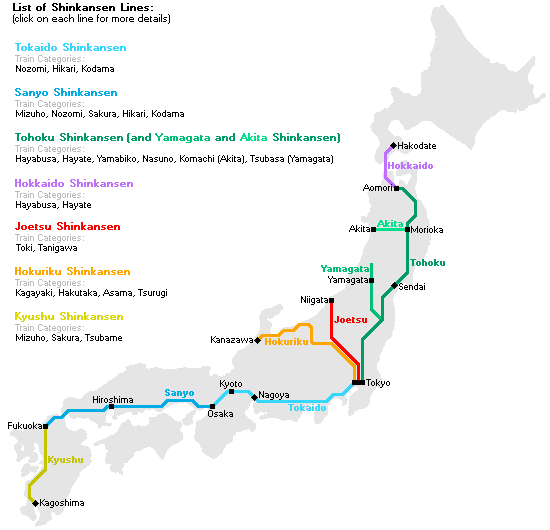
Shinkansen Tickets
Seat Classes
Most shinkansen trains in Japan offer seats in two classes, which are typically found in separate cars:
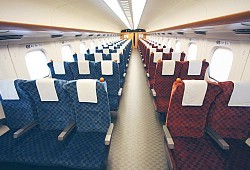 |
|
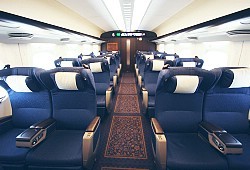 |
|
Furthermore, Gran Class is available on new train sets along the Tohoku Shinkansen, Hokuriku Shinkansen and Hokkaido Shinkansen. Comparable to first class on airplanes, Gran Class offers seats that are even more spacious and comfortable than Green Car seats (in rows of 2x1 seats) and additional amenities and services.
Reserved vs. non-reserved cars
Most shinkansen trains offer both non-reserved seats (自由席, jiyūseki) and reserved seats (指定席, shiteiseki) in separate cars. Only the Hayabusa, Hayate and Komachi trains on the Tohoku Shinkansen and Hokkaido Shinkansen and the Kagayaki trains on the Hokuriku Shinkansen are fully reserved and do not carry non-reserved seating. All seats in Green Cars are reserved. Bilingual signs indicate whether a shinkansen car carries reserved or non-reserved seats.
Advance seat reservations are required to use a seat in a reserved car (see below on how to make seat reservations). A fee of a few hundred yen applies for making seat reservations. Japan Rail Passholders can make seat reservations for free.
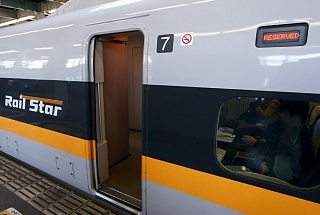 | 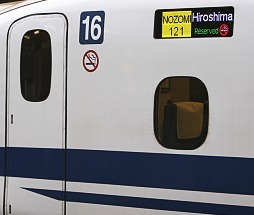 |
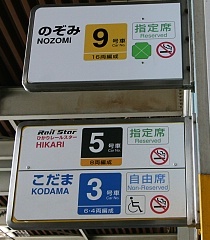 | 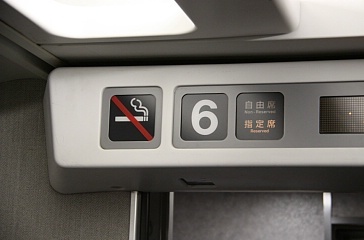 |
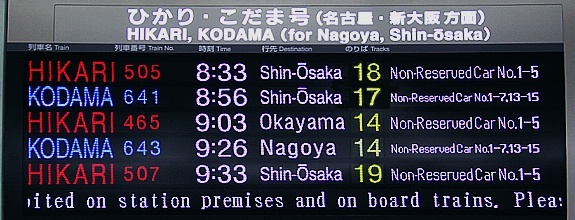
Regular Tickets
A shinkansen ticket is made up of several fees:
- Base fare
The fare to be paid to get from A to B. Increases step wise according to the distance traveled. Issued as a base fare ticket (乗車券, jōshaken). - Shinkansen supplement (limited express fee)
The supplement fee to be paid for using a shinkansen train (as opposed to a local train). The fee increases step wise according to the distance traveled. The express supplement is issued as a limited express fee ticket (特急券, tokkyūken). - Seat reservation fee
320, 520 or 720 yen depending on whether it is low season, regular season or high season respectively. An additional supplement (100-620 yen depending on distance traveled) applies for using reserved seats on Nozomi, Mizuho, Hayabusa and Komachi trains. The seat reservation fee is usually combined with the express supplement into a single ticket. - Green car fee
The supplement fee for riding the green car. Increases step wise according to the distance traveled. It is usually combined with the express supplement into a single ticket.
A passenger typically receives two pieces of tickets (a base fare ticket and a supplement ticket), although in some situations the two tickets are combined into a single ticket. If multiple trains are involved, there can be more than two tickets (one supplement ticket for each train).
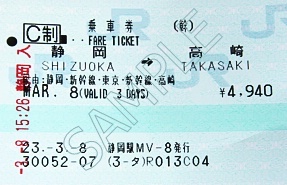 | 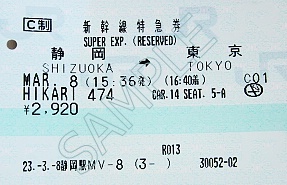 |
Rail Passes
The Japan Rail Pass can be used on all shinkansen trains except Nozomi and Mizuho trains and covers all the fees involved. Seat reservations can be made for free at ticket counters. Pass holders will receive a seat reservation ticket that indicates the reserved seat. They need no tickets besides their rail pass when using non-reserved seats. Similar to the nationwide Japan Rail Pass, there are numerous regional passes that also cover some shinkansen trains.
Other discount tickets
Small discounts are available for set ticket (回数券, kaisūken) and round trip tickets (往復割引, ōfukuwaribiki) that are available for selected sections. Other tickets provide a discount when purchased in advance (早得, hayatoku). Discount ticket shops around major stations also sell shinkansen tickets at small discounts.
Travel packages such as the various shinkansen tour packages by Japanican or the Puratto Kodama Economy Plan (for travel along the Tokaido Shinkansen by Kodama) can provide more substantial savings, but have to be purchased in advance.
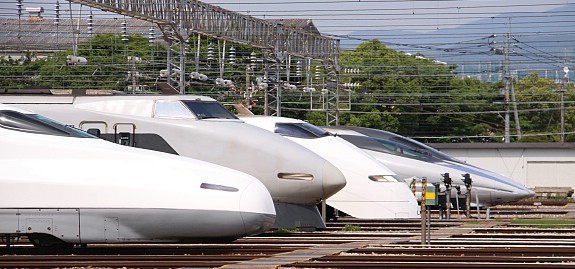
Seat Reservations
Seat reservations allow you to secure a seat and travel with peace of mind. They can be made for all shinkansen trains, but are not mandatory on the trains that also carry non-reserved seating. Only the Hayabusa, Hayate and Komachi trains along the Tohoku Shinkansen and Hokkaido Shinkansen, and the Kagayaki trains along the Hokuriku Shinkansen require seat reservations.
When and where can I make seat reservations?
Seat reservations can be made from one month before travel date (from 10:00am) until shortly before departure time. They can be made in various ways:
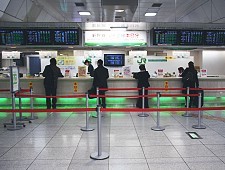 |
|
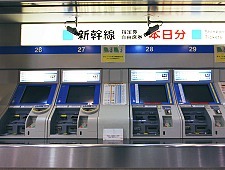 |
|
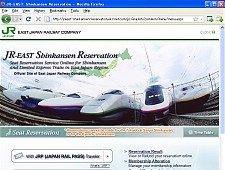 |
|
What information is needed to make a seat reservation?
In order to purchase a shinkansen ticket, the following information is needed:
- Number of travelers
- Date of travel
- Departure Station
- Destination Station
- Ordinary or green car
- Reserved or non-reserved seat
For a seat reservation, the following additional information is required:
- Train name (e.g. Hikari) and train number or departure time
- Preference of smoking or non-smoking seat, if available
If you do not speak Japanese, it is recommended that you write the data on a piece of paper and present it to the salesperson in order to make the purchasing process smoother. Salespersons are generally familiar with the English vocabulary needed for the purchase of train tickets and seat reservations, but many have limited English conversation skills.
How can I pay?
Cash and credit cards can be used at ticket counters and vending machines that sell shinkansen tickets. At some ticket counters, you should indicate at the beginning of your order that you will be paying by credit card. Japan Rail Pass holders can make seat reservations for free.
Are seat reservations recommended?
On many trains reserved seats do not get booked out, but on some they do. On particularly busy travel days (e.g. peak travel days during Golden Week, Obon and the New Year holidays), trains can get booked out several days in advance, but on most other days trains rarely get booked out more than a few hours in advance, if at all.
For peace of mind seat reservations are always recommended, especially when traveling in groups and preferring to sit together. On a few shinkansen trains along the Tohoku Shinkansen, Hokkaido Shinkansen and Hokuriku Shinkansen seat reservations are mandatory.
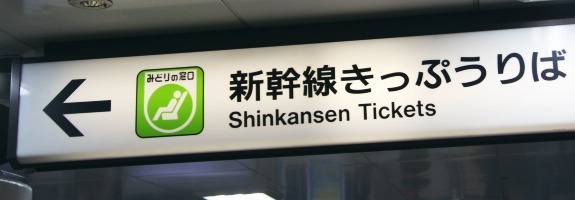
How to use the shinkansen?
After purchasing your ticket (see above), proceed as follows:
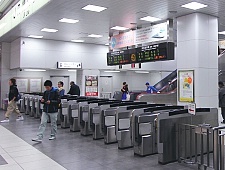 |
|
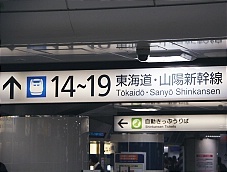 |
|
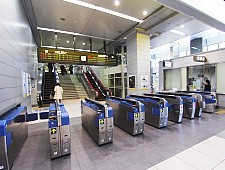 |
|
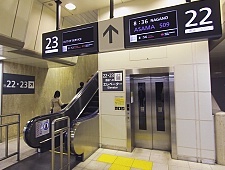 |
|
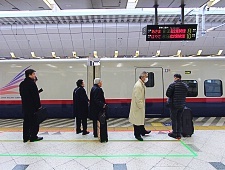 |
|
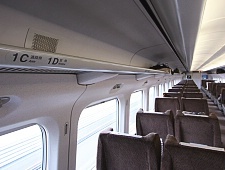 |
|
Your seat
Ordinary seats typically come in rows of 3x2 seats, although on some trains they are arranged in rows of 2x2 seats (and in rare cases in rows of 3x3 seats). Seats can be reclined and have tables, pockets for magazines and open overhead shelves. They provide considerably more foot space than economy seats on airplanes. Some newer train sets have electrical outlets installed along the walls.
Green cars always come with rows of 2x2 seats and have seats that are more spacious than ordinary seats. The seats are often equipped with a foot rest, reading light, electrical outlets (for aisle and window seats) and a seat warmer, although the exact facilities depend on the train set.
All seats on shinkansen trains can be turned by 180 degrees, allowing travelers to always face forward. The seats are turned by the staff at the terminal stations, but can also be turned by passengers, for example, to create a group of four or six seats facing each other.
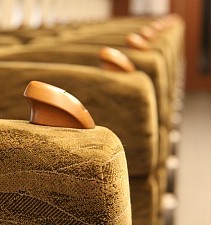 | 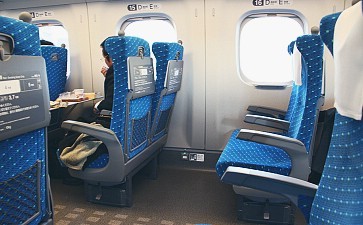 |
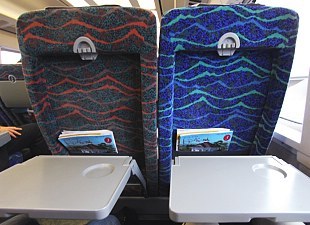 | 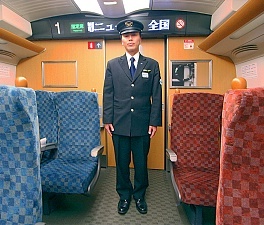 |
Amenities & Services
Signs and announcements inside the trains are multilingual (Japanese and English on all shinkansen lines; plus Korean and Chinese on selected lines) and inform about upcoming stations.
Most shinkansen trains are served by small food carts with a selection of snacks, drinks and boxed meals (bento) which periodically pass along the aisle. Some trains also have vending machines with drinks and pay phones. Wireless internet is available on the newest train sets between Tokyo and Shin-Osaka, however, a subscription or 1-day pass has to be purchased before boarding the train.
All shinkansen are equipped with multiple toilets, which are sometimes separated by gender. The toilets are Western style except on some older train sets. Newer train sets are also equipped with spacious toilets for wheel chair users. Outside the toilets are wash corners with sinks and large mirrors.
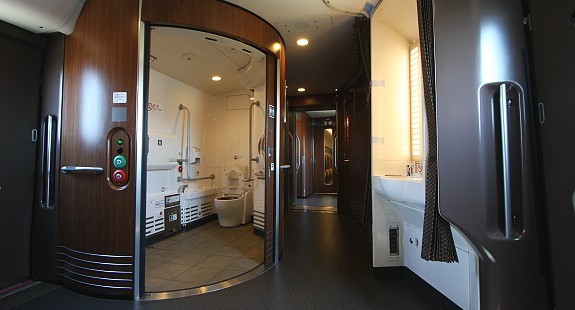
Smoking
Smoking is not allowed on most shinkansen trains. Prominent exception is the Tokaido/SanyoShinkansen on which some last smoking cars survive on older train sets. On newer train sets along the Tokaido/Sanyo Shinkansen, smoking is allowed only in small cabins with good ventilation that keep the trains free of smoke. On all other shinkansen lines, smoking is not possible.
Luggage
Shinkansen trains are equipped with relatively spacious overhead shelves (smaller on certain train sets) which can store small and medium sized bags and suitcases. Additionally, there is usually space for two or three large suitcases behind the last row of seats in each car. On many shinkansen trains the leg room is large enough to place a suitcase in front of you, although this may not be the most comfortable solution.
According to the rules book, each traveler is allowed to bring up to two pieces of luggage onto a train (not including small bags), with each piece not weighting more than 30 kilograms and not measuring more than 250 centimeters when adding up width, height and depth. However, even when bringing less than this upper limit, we recommend travelers with a lot of luggage to consider using a delivery service to make the trip more comfortable for themselves and the passengers around them.
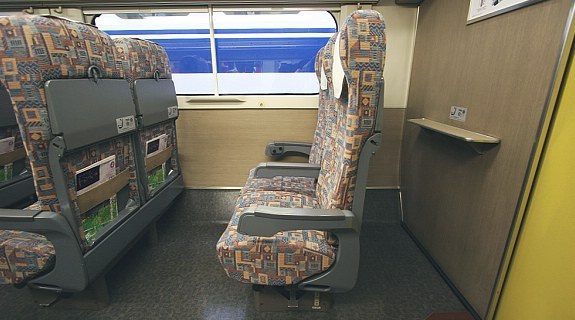
Shinkansen Manners
| Don't block the aisle with luggage. | |
| When having a conversation, keep your voice down. | |
| Recline your seat with consideration for the person behind you. Return the seat to its original position before exiting the train. | |
| Set your mobile phone to silent mode. Don't talk on your phone except in the deck areas between cars. | |
| Line up on the platform before boarding. |
Future of the Shinkansen
| Several new shinkansen routes are currently being built:
Hokkaido Shinkansen: extension from Hakodate via Niseko and Otaru to Sapporo in 2030.
Hokuriku Shinkansen: extension from Kanazawa to Tsuruga in 2022.
Kyushu Shinkansen (Nagasaki Route): a branch line to Nagasaki which partially uses existing regular tracks. Scheduled for completion by spring 2023.
Chuo Shinkansen: Using maglev technology, this new line is scheduled to connect Tokyo with Nagoya in 2027 and with Osaka by 2045.
| 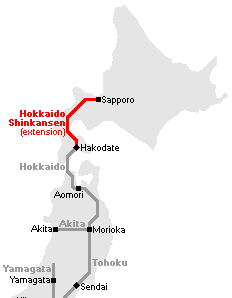 |
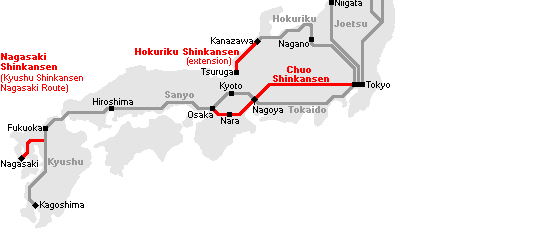 | |
Links
ENGLISH
high-speed rail network. The Shinkansen test train, popularly known as Doctor Yellow, is used to monitor the condition of tracks and overhead wires, helping to preserve the enviable safety record of the high-speed rail service. The vehicle’s nickname derives from its diagnostic function and distinctive yellow appearance.
It is often said that seeing a Doctor Yellow (there are several in service) brings good fortune. The fact that its schedule is not made public has added to this lucky reputation, with unexpected sightings adding color to people’s daily routines. Avid railfans are not content, however, to simply hope for a sudden and miraculous appearance. Instead they share information online to determine the trains’ whereabouts and ensure that they can enjoy a propitious encounter and photo opportunity.
Between Tokyo and Hakata
Japan’s first high-speed rail line—the Tōkaidō Shinkansen connecting Tokyo and Osaka—began operations in October 1964, and yellow T1 test trains were introduced the following January. They received major upgrades in 1974 and 2001. In the first of these, new vehicles combined previously separate checking of wires and tracks. The current sleek models came into use when increasingly rapid passenger services required a corresponding pace from the test trains.
The trains assess safety on Shinkansen lines between Tokyo and Hakata Station in Fukuoka on the island of Kyūshū. There are, in fact, two slightly different models—one for JR Central operating between Tokyo and Shin-Osaka and one for JR West from Shin-Osaka to Hakata. A similar test train called East-i travels on other Shinkansen lines, but it is white with a red stripe and does not, as yet, have the same cult following as Doctor Yellow.
Easy to Recognize
So why is the doctor yellow? As with previous vehicles performing diagnostic functions, the coloring was originally chosen to make the trains more visible at night. An additional benefit is that it makes them easy for travelers to recognize, so they do not try to climb on board. Color aside, the Doctor Yellow trains look much like their passenger Shinkansen counterparts, as well as moving like them, performing their checks at an equally speedy 270 kilometers per hour.
The interior is very different, however, with specialized monitoring equipment in each of the seven cars. There is a basic crew of nine, consisting of two drivers, three technicians responsible for the tracks, and four to oversee power-related issues. The equipment collects data on such aspects as wear in overhead wiring and whether the tracks have moved out of their correct alignment. The crew then analyzes the data, so repairs can be made as necessary.
 Visitors get a chance to look inside Doctor Yellow at a JR Central facility in Hamamatsu, Shizuoka Prefecture, on July 26, 2014. (© Jiji)
Visitors get a chance to look inside Doctor Yellow at a JR Central facility in Hamamatsu, Shizuoka Prefecture, on July 26, 2014. (© Jiji)Getting Closer
Doctor Yellow’s windows are blocked out, so it is not usually possible to see any of the equipment. There are, however, occasional opportunities to take tours inside. On March 13 this year, JR West opened up a test train to 400 participants in Hakata. JR Central holds similar events. Many applicants vie to win places on the tours. If it is lucky to see Doctor Yellow from the outside, it must be even more so to view the interior.
For those who cannot get up close, however, there is always the option of buying some of the many Doctor Yellow goods on sale. These include bentō boxes, backpacks, USB memory sticks, watches, and sneakers in the shape of the iconic test train, as well as socks, T-shirts, and other items adorned with its design. Tie-ups with popular characters like Hello Kitty and Rilakkuma are also common. Naturally, there are train sets too.
(Banner photo: Doctor Yellow passing in front of Lake Hamana in Shizuoka Prefecture. Photo by Zenshi/Pixta.)
الاشتراك في:
الرسائل (Atom)











































